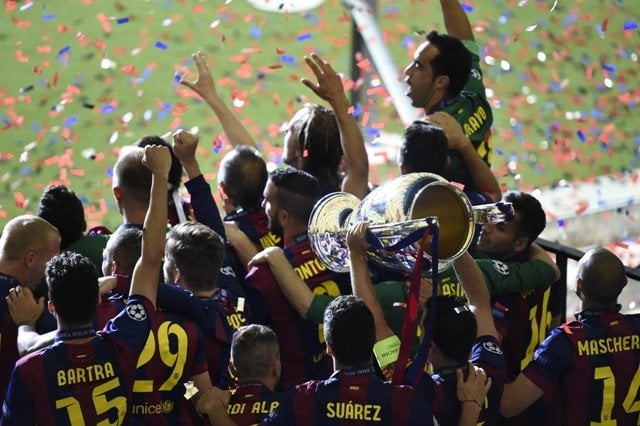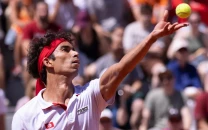Heaven and Hell in Berlin
Such is the beauty of football that triumph and despair, delight and agony go hand in hand

For club and country alike, Iniesta has always been there; happy in relinquishing the limelight to others so as to silently pull the strings from the shadows. PHOTO: AFP
They say the greatest trick the Devil ever pulled was convincing the world he didn't exist. In similar fashion, Andres Iniesta’s greatest trick has been to convince his opponents that he is not their single biggest threat — El Ilusionista’s greatest ever illusion.
Great players have the tendency to live for the big occasion, but perhaps none more so than Iniesta. The diminutive playmaker has now played in five Copa del Rey finals and four Champions League finals for Barcelona, along with two Euro finals and a World Cup final for Spain. He has won 10 of those 12 — tasting defeat in just two Copa del Rey finals — and is the only Barcelona player to have featured in all of Barcelona’s last four Champions League finals.
Yet again the man of the match in Barcelona’s 3-1 win over Juventus, Iniesta glided effortlessly into space before squaring the ball for an early Ivan Rakitic tap in. In the process he became the first ever player to assist in three different Champions League finals. He is also the only player to claim man of the match awards in a World Cup final (2010), a European Championship final (2012) and a Champions League final (2015).
Long has this been Iniesta’s way. He was there to score the stunning 93rd minute winner in the semi-final against Chelsea in 2009. He was there to send through Samuel Eto’o for the opener in the final the same year as Barcelona completed their first treble. He was there to score the winner in the 2010 World Cup final. He was there to lay off the ball to Messi for the Argentine’s winner in the 2011 Champions League final. He was there to pry open Italy’s defence and send Cesc Fabregas through in the Euro 2012 final in Spain’s opener. He was there to give Barcelona the early lead in Berlin.
For club and country alike, Iniesta has always been there; happy in relinquishing the limelight to others so as to silently pull the strings from the shadows.
But in Barcelona’s success he stands not alone and maybe even Iniesta cannot lay claim to being the club’s greatest talisman; that is Messi’s domain. There is little that can be said of the Argentina skipper that has not already been said. “He was so good that a lot of times I changed his position so he could adapt to all aspects of playing on the pitch. On one occasion I played him as sweeper, and it looked like he had been playing there all his life,” once said Gabriel Digerolamo, the Newell’s Old Boys coach that took an eight-year-old Messi under his wing.
The Argentine started off as the most promising kid in football, then became its most exciting youngster, then its greatest false nine, then its greatest goalscorer and, when questions were asked of his motivation, he has become the greatest playmaker today.
His superb cross field ball found the run of Neymar perfectly to start the move for the first goal. When Juventus threatened to take an unlikely lead and had momentum behind them, Messi conjured yet another mazy run and a stinging shot that Gianluigi Buffon could only parry to the obliging Luis Suarez. And in the dying embers of the game, he sent Neymar through to start the move that killed off the contest. Messi the false nine and Messi the goalscorer had determined Barcelona’s last two Champions League finals — this time around, it was Messi the playmaker.
It was a hell of a fitting 21-gun salute for Xavi; the third surviving member of Barcelona’s 2006 triumph. Xavi had scored his first European goal 15 years ago against Hertha Berlin. On June 6, he had come full circle on their home ground. One final hurrah for one of Europe’s most successful players.
Iniesta, Xavi, Messi. Never have colossuses been so diminutive in size and yet so great in stature and deed.
For all accolades heaped on Barcelona’s triumvirate of great natives though, it was those who adopted Barcelona rather than be born in it who stood tallest on the night. Rakitic and Suarez were both brought in this season for hefty sums and they went a long way in repaying those back with the goals that settled the tie. And it was controversial recruit Neymar, brought in for a similarly hefty sum last season, who provided the icing on the cake.
Berlin — from fond memories to broken hearts
Fewer sights in football have ever been as heartbreaking as seeing Andrea Pirlo, head bowed and crying, walk off the pitch where he had won the World Cup with Italy nine years ago.
He, like Xavi, is set to leave European football behind — the last remnants of Europe’s finest generation of midfielders.
In Buffon, Pirlo would find a friend to share the memories of Berlin with — fond and tragic alike. One of the best goalkeepers the world has ever seen is now all the more likely to end his career without claiming the biggest prize in European club football.
Those who say that the semi-final is the worst stage to lose have never lost a final, nor have they perhaps ever talked to Patrice Evra. The Frenchman will be sick and tired of Barcelona, having lost all three finals he has played against the Catalans; the first two with Manchester United and now with Juventus.
The scenes after the final whistle told their own story. For every screaming Dani Alves, there was an inconsolable Arturo Vidal. For Neymar’s tears of joy, there were Alvaro Morata’s tears of anguish. For every jubilant Adriano dancing in front of the fans, there was an exhausted Paul Pogba lying defeated on the turf.
Such is the beauty of football that triumph and despair, delight and agony go hand in hand. Berlin was no different, where met Heaven and Hell.
Like Sports on Facebook, follow @ETribuneSports on Twitter to stay informed and join in the conversation.



















COMMENTS
Comments are moderated and generally will be posted if they are on-topic and not abusive.
For more information, please see our Comments FAQ